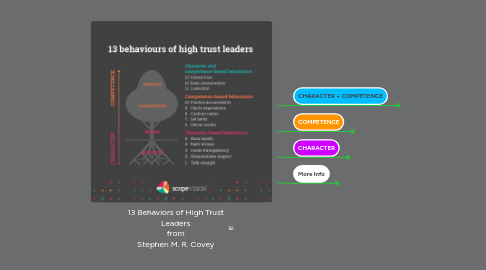
1. CHARACTER + COMPETENCE
1.1. Listen First
1.1.1. What to Say
1.1.1.1. Listen before speaking. Understand, diagnose,listen with ears, eyes and heart.
1.1.2. Opposite
1.1.2.1. Speak first and listen last or not listen at all.
1.1.3. Counterfeit
1.1.3.1. Listen just to formulate your response, pretend to listen.
1.2. Keep Commitments
1.2.1. What to Say
1.2.1.1. Say what you’ll do, then do it. Make commitments carefully and keep them at all costs. Don’t break confidences.
1.2.2. Opposite
1.2.2.1. Break commitments, violate promises.
1.2.3. Counterfeit
1.2.3.1. Make vague, elusive promises that can’t be pinned down.
1.3. Extend Trust
1.3.1. What to Say
1.3.1.1. Extend trust abundantly to those who’ve earned it, conditionally to those who are still earning it.
1.3.2. Opposite
1.3.2.1. Withhold trust.
1.3.3. Counterfeit
1.3.3.1. Extend false trust - giving responsibility without authority, then micromanage, “snoopervise” and hover.
2. COMPETENCE
2.1. Deliver Results
2.1.1. What to Say
2.1.1.1. Establish a track record of getting the right things done. Make things happen, on time and within budget. As Yoda says, “Do or do not, there is no try.”
2.1.2. Opposite
2.1.2.1. Overpromise and under-deliver.
2.1.3. Counterfeit
2.1.3.1. Delivering activities instead of results - doing busywork without accomplishing anything real.
2.2. Get Better
2.2.1. What to Say
2.2.1.1. Continuously improve. Increase your capabilities. Be a constant learner. Don’t consider yourself above feedback.
2.2.2. Opposite
2.2.2.1. Rest on your laurels, become irrelevant.
2.2.3. Counterfeit
2.2.3.1. Learning but never producing, force fitting things into what you’re good at.
2.3. Confront Reality
2.3.1. What to Say
2.3.1.1. Tackle all issues head-on, even the “undiscussables.” Address the tough stuff directly. Confront the reality, not the person.
2.3.2. Opposite
2.3.2.1. Ignore reality, be in denial.
2.3.3. Counterfeit
2.3.3.1. Focus on side issues while skirting the real issues.
2.4. Clarify Expectations
2.4.1. What to Say
2.4.1.1. Disclose, reveal and validate expectations. Don’t assume they’re clear or shared. Renegotiate if needed/possible.
2.4.2. Opposite
2.4.2.1. Leave expectations unclear or undefined.
2.4.3. Counterfeit
2.4.3.1. Guessing. Fail to pin down specifics for meaningful accountability.
2.5. Practice Accountability
2.5.1. What to Say
2.5.1.1. Hold yourself accountable first, others second. Take responsibility. Be clear on how you’ll communicate how you’re doing and how others are doing. Don’t blame
2.5.2. Opposite
2.5.2.1. Not take responsibility.
2.5.3. Counterfeit
2.5.3.1. Point fingers and blame others, fail to enforce consequences when expectations aren’t met.
3. CHARACTER
3.1. Talk Straight
3.1.1. What to Say
3.1.1.1. Be honest. Tell the truth. Let people know where you stand.
3.1.2. Opposite
3.1.2.1. Lie. Deceive.
3.1.3. Counterfeit
3.1.3.1. “Spinning,” positioning, posturing and manipulating.
3.2. Demonstrate Respect
3.2.1. What to Say
3.2.1.1. Care for others and show it. Treat everyone with respect, especially those who can’t do anything for you.
3.2.2. Opposite
3.2.2.1. Show disrespect or not care about others.
3.2.3. Counterfeit
3.2.3.1. Faking respect, showing respect for some but not all.
3.3. Create Transparency
3.3.1. What to Say
3.3.1.1. Tell the truth, be real, genuine, open and authentic
3.3.2. Opposite
3.3.2.1. Hide, cover up, obscure things.
3.3.3. Counterfeit
3.3.3.1. Having hidden agendas, withholding information.
3.4. Right Wrongs
3.4.1. What to Say
3.4.1.1. Admit when you’re wrong, apologize quickly, show humility, don’t let pride get in the way of doing the right thing.
3.4.2. Opposite
3.4.2.1. Deny, justify or rationalize wrongful behavior
3.4.3. Counterfeit
3.4.3.1. Cover up, disguise, hide mistakes until forced to admit error.
3.5. Show Loyalty
3.5.1. What to Say
3.5.1.1. Give credit to others, speak about people as if they’re present and represent others who aren’t there.
3.5.2. Opposite
3.5.2.1. Take credit, betray others.
3.5.3. Counterfeit
3.5.3.1. Being gossipy and two-faced, appearing to give credit when they’re present but downplaying their contribution and taking credit when they’re not around.
4. More Info
4.1. PDF
4.1.1. https://www.unthsc.edu/values/wp-content/uploads/sites/11/13-Behaviors-of-a-High-Trust-Leader.pdf
4.2. video
4.2.1. Stephen M R Covey on relationship trust and 13 behaviors of high trust people
4.2.2. Increase trust within your team: Stephen M. R. Covey
